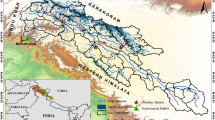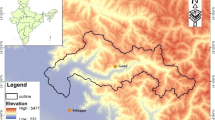Abstract
The study is focused on the estimation of component-wise runoff using temperature-index approach for the snow and glacier dominated Shyok River catchment; a sub-basin of the Upper Indus basin (UIB). Shyok River is a transboundary stream that has a catchment area of 33,465 km2 over three countries; Pakistan 28%, India 54%, and China 18%. To achieve the objective of the study, temperature-index approach-based snow and glacier melt runoff model (SRM+G) was applied in the Shyok River catchment for the duration of 2003–2014. The satellite-based remote-sensed MODIS snow-covered area (MOD10A1.005), NOAA RFE CA 2.0 precipitation and Landsat8 scenes’ extracted glacier extent were used in the model at daily time scale. SRTM 90m DEM was used for the catchment processing and its division into particular elevation zones in view of the modelling requirements. Based on the ground-observed temperature data of stations across UIB, an equation was developed using regression analysis for the estimation of temperature lapse rate (TLR) in the region. The daily temperature records at Hushey stations were projected for the constructed elevations zones using the estimated TLR of 0.64 °C per 100 m. The model was calibrated and validated using the daily streamflow record of Shyok River at Yogo station with a mean coefficient of determination (R2) of 0.93. An acceptable agreement of ± 10% error was achieved for the simulated annual inflow volume except for year 2010 that carried a rainfall-generated flood in summer season. The mean annual contribution from glacier melt, snowmelt and rainfall was estimated as 49%, 39% and 12%, respectively. The glacier melt was found to be the dominant contributor in the annual inflow. Snow-covered and glacier-exposed map** of the catchment was also carried out on long-term monthly basis. The findings of the study are beneficial for the water resources managers in the concerned organisations for the improved flow forecasting and water resources management in the region.






Similar content being viewed by others
Data Availability
The data can be requested from SWHP-WAPDA and PMD Pakistan.
References
Abas N, Khan N, Saleem MS, Raza MH (2019) Indus Water Treaty in the doldrums due to water–power nexus. Eur J Sec Res 4(2):201–242
Adnan M et al (2017a) Snowmelt runoff modelling under projected climate change patterns in the Gilgit River Basin of Northern Pakistan. Polish J Environ Stud 26(3). https://doi.org/10.15244/pjoes/66719
Adnan M, Nabi G, Poomee MS, Ashraf A (2017b) Snowmelt runoff prediction under changing climate in the Himalayan cryosphere: a case of Gilgit River Basin. Geosci Front 8(5):941–949
Ahmad Z, Hafeez M, Ahmad I (2012) Hydrology of mountainous areas in the upper Indus Basin, Northern Pakistan with the perspective of climate change. Environ Monitor Assess 184(9):5255–5274
Ali S, Li D, Congbin F, Khan F (2015) Twenty first century climatic and hydrological changes over Upper Indus Basin of Himalayan region of Pakistan. Environ Res Lett 10(1):014007
Amin A, Iqbal J, Asghar A, Ribbe L (2018) Analysis of current and future water demands in the Upper Indus Basin under IPCC climate and socio-economic scenarios using a hydro-economic WEAP model. Water 10(5):537
Anwar AA, Bhatti MT (2018) Pakistan’s water apportionment Accord of 1991: 25 years and beyond. J Water Resour Plan Manag 144(1):05017015
Athmania D, Achour H (2014) External validation of the ASTER GDEM2, GMTED2010 and CGIAR-CSI-SRTM v4. 1 free access digital elevation models (DEMs) in Tunisia and Algeria. Remote Sens 6(5):4600–4620
Atif I, Mahboob MA, Iqbal J (2015) Snow cover area change assessment in 2003 and 2013 using MODIS data of the Upper Indus Basin Pakistan. J Himalayan Earth Sci 48(2):117
Bajracharya SR, Shrestha BR (2011) The status of glaciers in the Hindu Kush-Himalayan region. International Centre for Integrated Mountain Development (ICIMOD)
Bhambri R et al (2013) Heterogeneity in glacier response in the upper Shyok valley, northeast Karakoram. Cryosphere 7(5):1385–1398
Biswas AK (1992) Indus water treaty: The negotiating process. Water Int 17(4):201–209
Bogacki W, Hashmi D (2013) Impact of climate change on the flow regime of the Mangla Basin. In: GWSP Conference Water in the Anthropocene: Challenges for Science and Governance, vol. 10. Indicators, Thresholds and Uncertainties of the Global Water System, Bonn, Germany
Braithwaite RJ, Zhang Y (1999) Modelling changes in glacier mass balance that may occur as a result of climate changes. Geografiska Annaler: Series A, Phys Geogr 81(4):489–496
Chen Y, Xu Y, Yin Y (2009) Impacts of land use change scenarios on storm-runoff generation in **tiaoxi basin China. Quater Int 208(1-2):121–128
Diaz HF, Grosjean M, Graumlich L (2003) Climate variability and change in high elevation regions: past, present and future. Climatic Change 59(1):1–4
Hall DK, Salomonson VV (2006) MODIS Snow Products User Guide to Collection 5 George A. Riggs
Hasson S et al (2014) Early 21st century snow cover state over the western river basins of the Indus River system. Hydrol Earth Sys Sci 18(10):4077–4100
Hayat H et al (2019) Simulating current and future river-flows in the Karakoram and Himalayan regions of Pakistan using snowmelt-runoff model and RCP scenarios. Water 11(4):761
Immerzeel W, Droogers P, de Jong S, Bierkens M (2010) Satellite derived snow and runoff dynamics in the Upper Indus River basin. Grazer Schriften der Geographie und Raumforschung 45:303–312
Ismail MF, Bogacki W, Muhammad N et al (2015) Degree day factor models for forecasting the snowmelt runoff for Naran Watershed. Sci Int 27:3
Isioye OA, Yang IC (2013) Comparison and validation of ASTER-GDEM and SRTM elevation models over parts of Kaduna State. SASGI Proceedings, Nigeria
Jain SK, Singh VP (2003) Water resources systems planning and management. Elsevier
Johnston R, Smakhtin V (2014) Hydrological modeling of large river basins: how much is enough? Water Res Manag 28(10):2695–2730
Khalili M, Leconte R, Brissette F (2007) Stochastic multisite generation of daily precipitation data using spatial autocorrelation. J Hydrometeorol 8(3):396–412
Khan S, Ashiq M, Gabriel H (2014) Assessment of flows in a glaciated region-Shigar River Basin. Technical Journal, University of Engineering and Technology Taxila, Pakistan, p 19
Latif Y et al (2020) Differentiating snow and glacier melt contribution to runoff in the Gilgit River basin via degree-day modelling approach. Atmosphere 11(10):1023
Latif Y, Ma Y, Ma W, Sher M, Muhammad Y (2018) Snowmelt runoff simulation during early 21st century using hydrological modelling in the Snow-Fed Terrain of Gilgit River Basin (Pakistan). In: Conference of the Arabian Journal of Geosciences. Springer, pp 73–76
Leavesley G (1989) Problems of snowmelt runoff modelling for a variety of physiographic and climatic conditions. Hydrol Sci J 34(6):617–634
Liu Z, Todini E (2002) Towards a comprehensive physically-based rainfall-runoff model. Hydrol Earth Syst Sci 6(5):859–881
Lone SA, Jeelani G, Padhya V, Deshpande RD (2022) Identifying and estimating the sources of river flow in the cold arid desert environment of Upper Indus River Basin (UIRB), western Himalayas. Sci Total Environ 832(2022):154964. https://doi.org/10.1016/j.scitotenv.2022.154964
Martinec J, Rango A (1989) Merits of Statistical Criteria for the Performance of Hydrological Models 1. JAWRA J Am Water Res Ass 25(2):421–432
Mehmood A et al (2021) Detection of spatial shift in flood regime of the Kabul river basin in Pakistan, causes, challenges, and opportunities. Water 13(9):1276
Mirchi A, Watkins D Jr, Madani K (2010) Modeling for watershed planning, management, and decision making. In: Watersheds: management, restoration and environmental impact. Nova Science Publishers, New York, pp 1–25
Moriasi DN et al (2007) Model evaluation guidelines for systematic quantification of accuracy in watershed simulations. Trans ASABE 50(3):885–900
Mount NJ et al (2016) Data-driven modelling approaches for socio-hydrology: opportunities and challenges within the Panta Rhei Science Plan. Hydrol Sci J 61(7):1192–1208
Mukhopadhyay B, Khan A (2015) A reevaluation of the snowmelt and glacial melt in river flows within Upper Indus Basin and its significance in a changing climate. J Hydrol 527:119–132
Nabi G, Latif M, Azhar AH (2011) The role of environmental parameter (degree day) of snowmelt runoff simulation. Soil Environ 30:1
Oerlemans J et al (1998) Modelling the response of glaciers to climate warming. Climate Dyn 14(4):267–274
Rango A, Martinec J (1995) Revisiting the degree-day method for snowmelt computations 1. JAWRA J Am Water Resour Ass 31(4):657–669
Saeed F, Jehangir S, Noaman-ul-Haq M, Shafeeq W, Hashmi MZ, Ali G, Khan AM (2009) Application of UBC and DHSVM models for selected catchments of Indus Basin Pakistan. GCISC-RR-11, Pakistan
Schaper J, Seidel K (2000) Modelling daily runoff from snow and glacier melt using remote sensing data. In: Proceedings of the 2nd EARSel Workshop. Special Interest Group Land Ice and Snow, pp 308–316
Schaper J, Martinec J, Seidel K (1999) Distributed map** of snow and glaciers for improved runoff modelling. Hydrol Proc 13(12-13):2023–2031
Sharma V, Mishra V, Joshi P (2014) Topographic controls on spatio-temporal snow cover distribution in Northwest Himalaya. Int J Remote Sens 35(9):3036–3056
Shroder J (1993) Himalaya to the Sea. Geology, Geomorphology
Tahir AA, Chevallier P, Arnaud Y, Ahmad B (2011a) Snow cover dynamics and hydrological regime of the Hunza River basin, Karakoram Range, Northern Pakistan. Hydrol Earth Syst Sci 15(7):2275–2290
Tahir AA, Chevallier P, Arnaud Y, Neppel L, Ahmad B (2011b) Modeling snowmelt-runoff under climate scenarios in the Hunza River basin, Karakoram Range, Northern Pakistan. J Hydrol 409(1-2):104–117
Treaty IW (1960) The Indus waters treaty. Signed at Karachi on Sept 19(1960):300–365
Umar M, Shakir AS, Rehman H (2015) Estimation of snowmelt contribution for Kalam catchment. Pak J Eng Appl Sci 2015
Wang J et al (2011) The coupled routing and excess storage (CREST) distributed hydrological model. Hydrol Sci J 56(1):84–98
Winston Y, Yang Y-C, Savitsky A, Alford D, Brown C (2013) The Indus basin of Pakistan: The impacts of climate risks on water and agriculture. World Bank, Washington, DC, License: Creative Commons Attribution CC BY 3.0. https://doi.org/10.1596/978-0-8213-9874-6
WMO, W (1986) Intercomparison of models of snowmelt runoff. Oper Hydrol Rep 23:21–32
Wu K et al (2021) Quantification of glacier mass budgets in the Karakoram region of Upper Indus Basin during the early twenty-first century. J Hydrol 603:127095
Acknowledgements
The authors acknowledge the Surface Water Hydrology Project, Glacier Monitoring Research Centre, Water and Power Development Authority, Pakistan Meteorological Department, International Centre for Tropical Agriculture, National Oceanic Atmospheric Administration, National Aeronautics and Space Administration and the United States Geological Survey for making possible the availability of required data to coagulate this research work. The author also acknowledges the assistance of Mr. Adil Latif, GIS Expert NESPAK.
Funding
This was self-funded research. It was carried out as part of the degree requirement for the Masters’s program in Hydraulics and Irrigation Engineering at the University of Engineering and Technology Lahore, Pakistan.
Author information
Authors and Affiliations
Contributions
Muhammad Umar Farooq and Dr. Muhammad Ashiq Kharal designed the research plan. Muhammad Umar Farooq and Muhammad Fraz Ismail performed the analysis and interpreted the results. Asif Mehmood contributed in the discussions. Dr. Wolfgang Bogacki supervised the research. He also provided valuable suggestions for the improvement of the article. All authors read and approved the final manuscript.
Corresponding author
Ethics declarations
Ethics approval
Ok
Consent to participate
Ok
Consent for publication
Ok
Competing interests
The authors declare that they have no competing interests.
Additional information
Responsible Editor: Broder J. Merkel
Rights and permissions
Springer Nature or its licensor (e.g. a society or other partner) holds exclusive rights to this article under a publishing agreement with the author(s) or other rightsholder(s); author self-archiving of the accepted manuscript version of this article is solely governed by the terms of such publishing agreement and applicable law.
About this article
Cite this article
Farooq, M.U., Kharal, M.A., Bogacki, W. et al. Estimation of component-wise runoff contribution using temperature index approach, in a snow- and glacier-fed transboundary Shyok River catchment of the Upper Indus Basin. Arab J Geosci 16, 460 (2023). https://doi.org/10.1007/s12517-023-11583-y
Received:
Accepted:
Published:
DOI: https://doi.org/10.1007/s12517-023-11583-y




